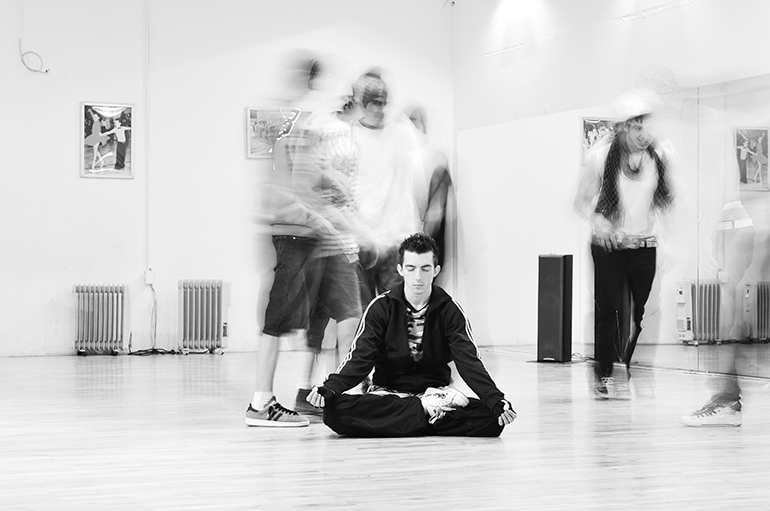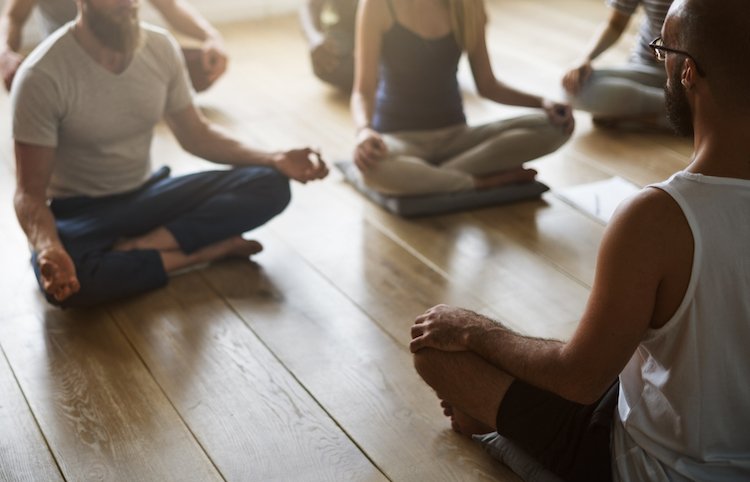As well as the usual physical and mental benefits, practising yoga can be a useful tool in healing trauma and PTSD. Sienna Saint-Cyr tried out trauma sensitive yoga and Neurogenic Yoga™ and shares her experience.
According to Yoga Journal, there are 38 health benefits to having a daily yoga practice. There are the potential physical gains, such as increased flexibility, lymph node drainage, boosted circulation and lowered blood pressure. And then there's the mental aspects of health such as increased focus and the relief of anxiety and depression. Healing trauma through yoga is also something that can be achieved, using the practice of trauma sensitive yoga.
The Yoga Journal isn’t alone in its claims. Organizational bodies including the American Osteopathic Association share its views on yoga in relation to physical and mental health. With the benefits of yoga become increasingly clear, it's no surprise that in recent years there has been a massive surge in interest in yoga within Western culture. However, while this 'yoga boom' was a positive step, there are now so many types and styles that it can often be difficult to find one that works well for you.
Healing trauma with yoga
I have a saying: “Yoga is as personal as underwear.” It either fits us and our needs or it doesn’t. For most folks, exploring various YouTube channels or videos is enough. For others, it's going to gym classes or local yoga studios.
But for anyone with trauma, especially if it’s something like PTSD, these methods of exploration become intolerable, if not impossible. For many people, it's difficult to find peace while being constantly worried about the people in the room who might potentially touch them or when it's suddenly becomes too loud. Or when getting too close is anything but relaxing: having a panic attack in the middle of class isn’t the desired effect!

With trauma sensitive yoga, you can leave the class without fear
Trauma sensitive yoga: what is it?
Thankfully, in 2002, a man named David Emerson discovered he could treat trauma using yoga. He reached out to Dr. Bessel van der Kolk about his findings and desire to do more in the field. Together, they created a platform that would later become trauma sensitive yoga (TSY), specifically used to help people with trauma and PTSD.
Over the course of several years, Emerson brought in different yoga instructors with varying expertise to assist in the development of the program. The National Institutes of Health even funded their trial.
RELATED: Compassion yoga
Trauma sensitive yoga is different from other yoga practices in many ways. Depending on the studio, the methods will vary, but usually, the classes are small.
And, unlike traditional yoga classes where you might get some serious side eye for leaving mid-session and disturbing the peaceful atmosphere, anyone can quietly come and go as they need during trauma sensitive yoga. There's an understanding when you come to class about the sensitive nature of what's about to happen.
“For many people with PTSD, it's difficult to find peace while being constantly worried about the people in the room who might potentially touch them.”
The studio I tried, Samdhana-Karana Yoga, was very low pressure. The instructor was also a therapist and had worked with trauma patients before. She also had my therapist’s number and emergency contacts in case of triggering.
The prep work that went into the class even before I began was like nothing I’d experienced before. This encouraged me to feel like I was in a safe space. Normally you can just show up at a studio or gym pay the fee and take the class. It's all quite impersonal for someone with trauma, in need of assurance that if something goes wrong, they're still in a safe space.
Your body, your practice
There's a lot of focus on ‘your body, your practice’. That helps the practitioner remember to honor their needs because it’s ‘their’ practice. Rather than performing traditional yoga poses, trauma sensitive yoga encourages people to move as they need to, with minimal and gentle hands-on guidance.
Group gains: use yoga to help heal trauma
Attendees are asked to pay attention to contact points, i.e. the point where your back touches the ground, or your feet or hands, how much pressure there is, and so on. There are often no hard yoga moves or poses because the focus is on making it a safe space for those with trauma to heal and experience mindfulness with yoga. There are some great videos on the TSY website that give brief examples of what trauma based yoga looks like.
What is Neurogenic Yoga™?
Trauma sensitive yoga isn’t the only option for trauma sufferers either. Another is Neurogenic Yoga™. While similar in many ways, Neurogenic Yoga™ stands out because it combines yoga asana and pranayama with the body’s natural, therapeutic shaking response.
Why is that last part so important? Peter A. Levine, PhD, the developer of Somatic Experiencing and founder of the Foundation for Human Enrichment, has spent his life researching and treating trauma in patients. Some of his groundbreaking research includes the practice of releasing trauma through the body.
“Unlike traditional yoga classes where you might get serious side eye for leaving mid-session, anyone can quietly come and go during trauma sensitive yoga.”
In one of his books, In an Unspoken Voice: How the Body Releases Trauma and Restores Goodness, Levine discusses how the body has a natural response to trauma. When our fight or flight responses don’t get to finish their cycle, we enter into so-called 'fawning or freezing', thus creating trauma and storing it within the body. Levine believes that by allowing the body to finish out the cycle of trauma – meaning allowing the body to shake when it needs to until it stops on its own – that we can heal our trauma.
His book and research are phenomenal and I highly recommend them to anyone with trauma. So, Neurogenic Yoga™ including shaking into their trauma treatment is fantastic. While trauma sensitive yoga helps, people that have trauma from car accidents, military tours, and violent attacks need a bit more than just the relaxation. They need to be allowed to shake and move the body in a different sort of way to release that trauma physically.
How trauma and a wandering mind relate
Trauma and PTSD are tiring. The problem with trauma is that the sufferer is rarely present in their body. Pete Walker is another expert, specifically on Complex PTSD, and his studies into the Four F’s – fight, flight, freeze and fawn – explain a lot about why people with PTSD can seldom find relaxation.
Rather than experience healthy and balanced responses with the Four F's – because we all have these responses – people with PTSD have two responses that they lean heavily on. So, sufferers can get trapped in constant fight and flight or freeze and fawn. This means we aren’t present in daily life. We’re stuck on the ‘spin’ of PTSD and trauma. And when we’re stuck spinning and unable to be present, we aren’t able to experience joy and happiness.
Being present leads to happiness
To dig into this a bit further, Science AAAS reported its findings on how being present leads to happiness, while mind wandering leads to unhappiness. This is different from a popular assumption that unhappiness leads to mind wandering. While mood can certainly lead to focusing on the past or future, it's not, in itself, the cause of unhappiness. It’s the focus on past and future, an unhealthy rumination, that leads to the unhappiness.
RELATED: Jill Satterfield, a mindful approach to yoga
The Science AAAS article wraps with: “In conclusion, a human mind is a wandering mind, and a wandering mind is an unhappy mind. The ability to think about what is not happening is a cognitive achievement that comes at an emotional cost.”
Trauma sensitive yoga can assist with pulling the practitioner into the present using gentle and non-threatening ways. For people with trauma, they mostly live in the past or in a place of fear surrounding the future. It's this lack of being present that directly relates to their unhappiness. The beauty of trauma sensitive yoga is that it takes you out of this place of fear. It trains your body to remake past experiences and to release them in a physically productive way.
No matter which method you try – trauma sensitive yoga or Neurogenic Yoga™ – taking part in trauma based yoga can make a huge difference to your experience. It can also assist in finding your own breath; a breath that brings peace in with each in-breath and releases tension and stress with every out-breath.
Trauma based yoga teaches those who aren’t generally present in their own body, how to do just that. If you are living with trauma or PTSD, then I believe that trauma sensitive yoga can work wonders. It can lead to a life full of joy and happiness through a daily practice of being present and living in the moment. ●
Main image: Colorbox.com
happiness.com | The fine art of being: learn, practise, share
Are you a happiness.com member yet? Sign up for free now to:
■ enjoy our happiness magazine with practical life tips
■ share and support others in our happiness forum
■ learn with free online classes in our happiness Academy
Written by Sienna Saint-Cyr
 Sienna Saint-Cyr is an author, advocate, and the founder of SinCyr Publishing. She speaks at conventions, workshops, and for private gatherings on the importance of having a healthy body image, understanding enthusiastic consent, using sexuality to promote healing, navigating diverse or non-traditional relationships, having trauma, Complex PTSD, and more. Sienna loves sharing her journey of healing and finding happiness with her readers. Along with writing erotica and romance, Sienna speaks at conventions, workshops, and for private gatherings on such sex-positive topics as a healthy body image, using sexuality to promote healing, and navigating diverse or non-traditional relationships. She writes for several websites. Find out more.
Sienna Saint-Cyr is an author, advocate, and the founder of SinCyr Publishing. She speaks at conventions, workshops, and for private gatherings on the importance of having a healthy body image, understanding enthusiastic consent, using sexuality to promote healing, navigating diverse or non-traditional relationships, having trauma, Complex PTSD, and more. Sienna loves sharing her journey of healing and finding happiness with her readers. Along with writing erotica and romance, Sienna speaks at conventions, workshops, and for private gatherings on such sex-positive topics as a healthy body image, using sexuality to promote healing, and navigating diverse or non-traditional relationships. She writes for several websites. Find out more.





Join the conversation
You are posting as a guest. If you have an account, sign in now to post with your account.